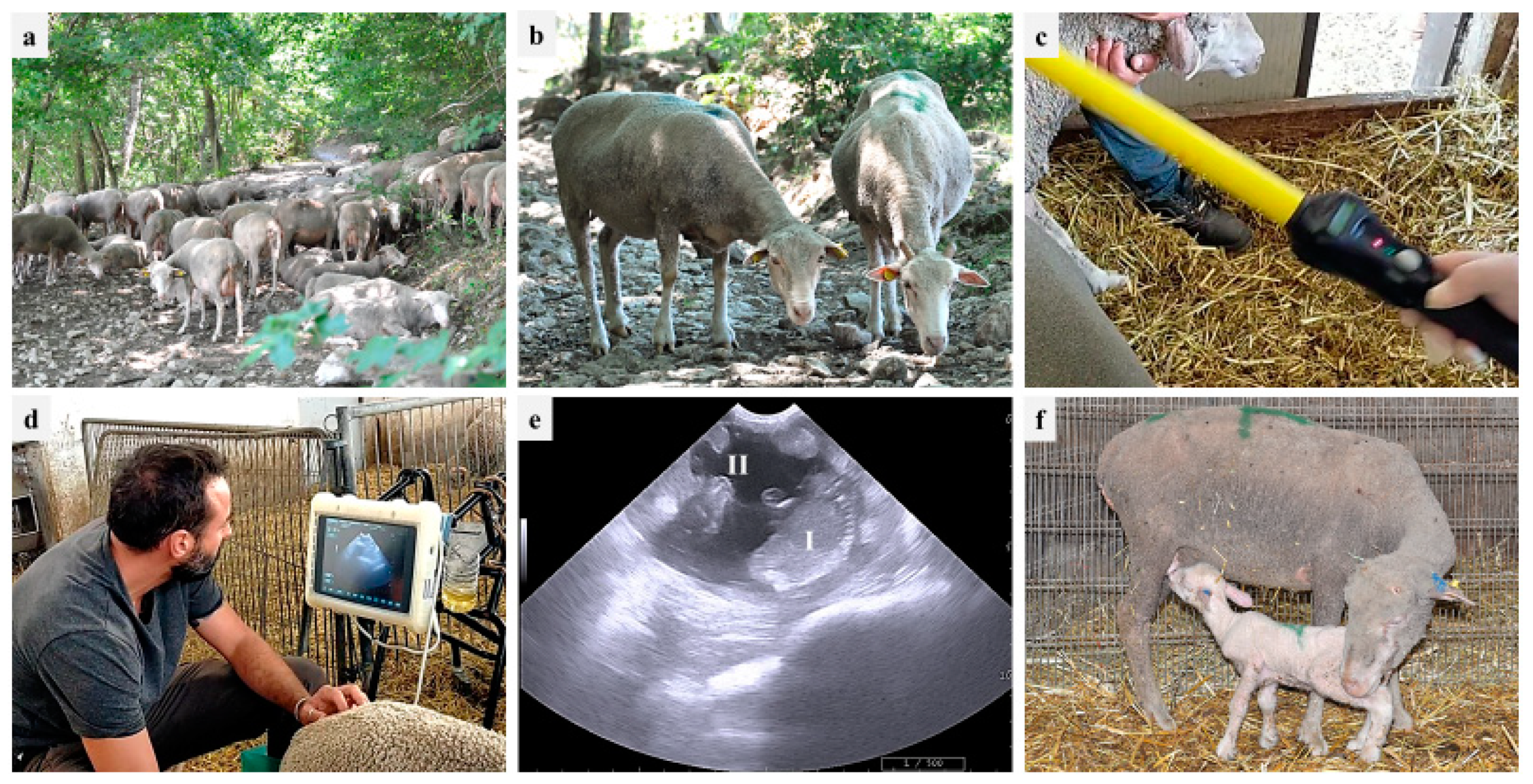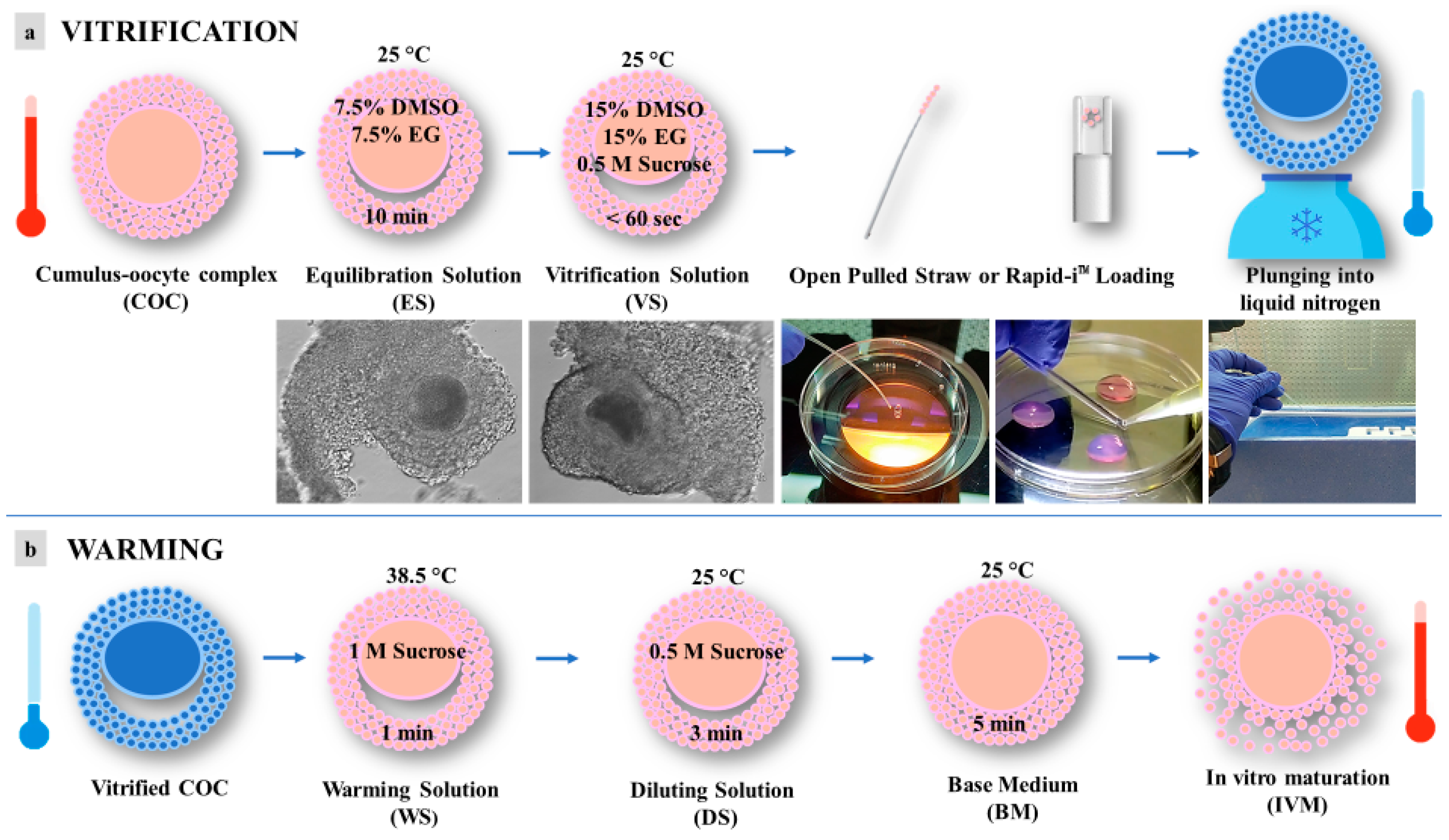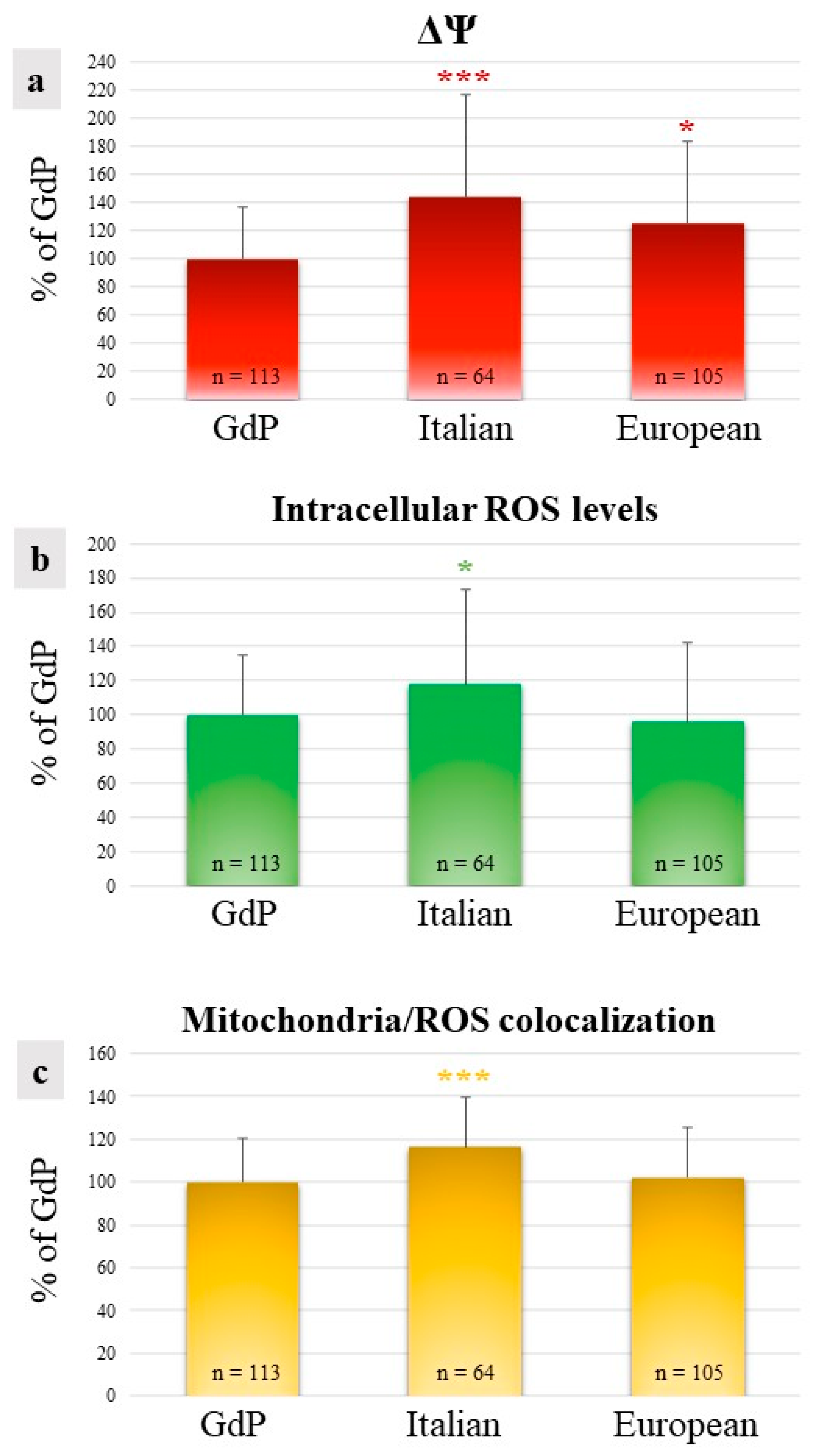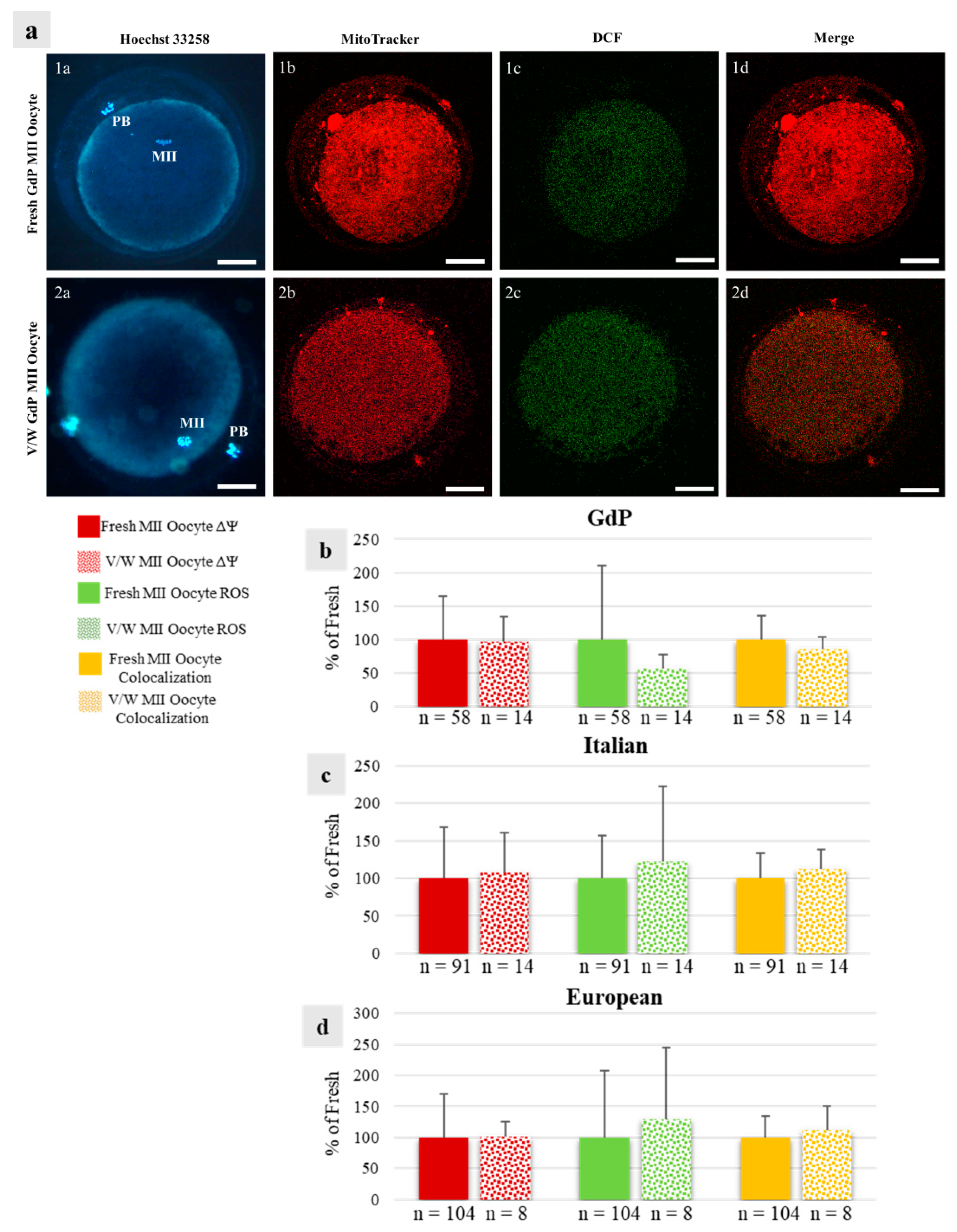New Strategies for Conservation of Gentile di Puglia Sheep Breed, an Autochthonous Capital of Millennial Tradition in Southern Italy
Abstract
Simple Summary
Abstract
1. Introduction
2. Materials and Methods
2.1. Routine Veterinary Checkups
On-Farm Evaluation of Reproductive Efficiency
2.2. In Vitro Study
2.2.1. Chemicals
2.2.2. Collection of Ovaries and COC Retrieval
2.2.3. Vitrification and Warming Procedures
2.2.4. In Vitro Maturation (IVM)
2.2.5. Assessment of Cumulus Expansion and Oocyte Denuding
2.2.6. Oocyte Mitochondria and ROS Staining
2.2.7. Oocyte Nuclear Chromatin Evaluation
2.2.8. Assessment of Mitochondrial Distribution Pattern and Intracellular ROS Localization
2.2.9. Quantification of Bioenergetic/Oxidative Parameters
2.2.10. Statistical Analysis
3. Results
3.1. On-Farm Evaluation of Reproductive Efficiency
3.2. GdP Pre-Pubertal Lamb COCs Achieve Meiotic Maturation after IVM
3.3. GdP Pre-Pubertal Lamb MII Oocytes Show Healthy Bioenergetic/Oxidative Status after IVM
3.4. Vitrification of GdP Pre-Pubertal Lambs’ Immature COCs Reduce Their Meiotic Maturation after IVM
3.5. Vitrification of GdP Pre-Pubertal Lambs’ Immature COCs Does Not Affect Their Bioenergetic/Oxidative Status after IVM
4. Discussion
5. Conclusions
Author Contributions
Funding
Institutional Review Board Statement
Informed Consent Statement
Data Availability Statement
Acknowledgments
Conflicts of Interest
References
- Woelders, H.; Windig, J.; Hiemstra, S.J. How developments in cryobiology, reproductive technologies and conservation genomics could shape gene banking strategies for (farm) animals. Reprod. Domest. Anim. 2012, 47 (Suppl. 4), 264–273. [Google Scholar] [CrossRef] [PubMed]
- Ciani, E.; Crepaldi, P.; Nicoloso, L.; Lasagna, E.; Sarti, F.M.; Moioli, B.; Napolitano, F.; Carta, A.; Usai, G.; D’Andrea, M.; et al. Genome-wide analysis of Italian sheep diversity reveals a strong geographic pattern and cryptic relationships between breeds. Anim. Genet. 2014, 45, 256–266. [Google Scholar] [CrossRef] [PubMed]
- D’Angelo, F.; Albenzio, M.; Sevi, A.; Ciampolini, R.; Cecchi, F.; Ciani, E.; Muscio, A. Genetic variability of the Gentile di Puglia sheep breed based on microsatellite polymorphism. J. Anim. Sci. 2009, 87, 1205–1209. [Google Scholar] [CrossRef]
- Sardaro, R.; La Sala, P. New value to wool: Innovative garments for preservation of sheep landraces in Italy. Animals 2021, 11, 731. [Google Scholar] [CrossRef]
- Cryoconservation of animal genetic resources. In FAO Animal Production and Health Guidelines No. 12; FAO: Rome, Italy, 2012; pp. 3–5.
- Jones, A.K.; Gately, R.E.; McFadden, K.K.; Zinn, S.A.; Govoni, K.E.; Reed, S.A. Transabdominal ultrasound for detection of pregnancy, fetal and placental landmarks, and fetal age before Day 45 of gestation in the sheep. Theriogenology 2016, 85, 939–945. [Google Scholar] [CrossRef]
- Noakes, D.; Parkinson, T.; England, G. Veterinary Reproduction and Obstetrics, 10th ed.; Elsevier: Amsterdam, The Netherlands, 2018; pp. 78–114. [Google Scholar]
- Mujitaba, M.A.; Vass, N.; Bodó, S. The recent state of cryopreservation techniques for ex-situ gene conservation and breeding purposes in small ruminants: A review. Acta Agrar. Debr. 2020, 1, 81–87. [Google Scholar] [CrossRef]
- Boes, J.; Boettcher, P.; Honkatukia, M. Innovations in cryoconservation of animal genetic resources-Practical guide. In FAO Animal Production and Health Guidelines, No. 33; FAO: Rome, Italy, 2023; pp. 41–67. [Google Scholar]
- Prentice, J.R.; Anzar, M. Cryopreservation of mammalian oocyte for conservation of animal genetics. Vet. Med. Int. 2010, 2011, 146405. [Google Scholar] [CrossRef]
- Turathum, B.; Gao, E.M.; Chian, R.C. The function of cumulus cells in oocyte growth and maturation and in subsequent ovulation and fertilization. Cells 2021, 10, 2292. [Google Scholar] [CrossRef]
- Bogliolo, L.; Ariu, F.; Fois, S.; Rosati, I.; Zedda, M.T.; Leoni, G.; Succu, S.; Pau, S.; Ledda, S. Morphological and biochemical analysis of immature ovine oocytes vitrified with or without cumulus cells. Theriogenology 2007, 68, 1138–1149. [Google Scholar] [CrossRef]
- Colombo, M.; Alkali, I.M.; Luvoni, G.C. Microenvironment factors promoting the quality of vitrified cat oocytes. Theriogenology 2023, 196, 275–283. [Google Scholar] [CrossRef]
- Moawad, A.R.; Fisher, P.; Zhu, J.; Choi, I.; Polgar, Z.; Dinnyes, A.; Campbell, K.H.S. In vitro fertilization of ovine oocytes vitrified by solid surface vitrification at germinal vesicle stage. Cryobiology 2012, 65, 139–144. [Google Scholar] [CrossRef] [PubMed]
- Moawad, A.R.; Zhu, J.; Choi, I.; Amarnath, D.; Chen, W.; Campbell, K.H. Production of good-quality blastocyst embryos following IVF of ovine oocytes vitrified at the germinal vesicle stage using a cryoloop. Reprod. Fertil. Dev. 2013, 25, 1204–1215. [Google Scholar] [CrossRef] [PubMed]
- Shirazi, A.; Taheri, F.; Nazari, H.; Norbakhsh-Nia, M.; Ahmadi, E.; Heidari, B. Developmental competence of ovine oocyte following vitrification: Effect of oocyte developmental stage, cumulus cells, cytoskeleton stabiliser, FBS concentration, and equilibration time. Zygote 2014, 22, 165–173. [Google Scholar] [CrossRef] [PubMed]
- Quan, G.B.; Wu, G.Q.; Wang, Y.J.; Ma, Y.; Lv, C.R.; Hong, Q.H. Meiotic maturation and developmental capability of ovine oocytes at germinal vesicle stage following vitrification using different cryodevices. Cryobiology 2016, 72, 33–40. [Google Scholar] [CrossRef] [PubMed]
- Naderi, M.M.; Borjian Boroujeni, S.; Sarvari, A.; Heidari, B.; Akhondi, M.M.; Zarnani, A.H.; Shirazi, A. The effect of media supplementation with angiotensin on developmental competence of ovine embryos derived from vitrified-warmed oocytes. Avicenna J. Med. Biotechnol. 2016, 8, 139–144. [Google Scholar]
- Moawad, A.R.; Choi, I.; Zhu, J.; El-Wishy, A.B.A.; Amarnath, D.; Chen, W.; Campbell, K.H.S. Caffeine and oocyte vitrification: Sheep as an animal model. Int. J. Vet. Sci. Med. 2018, 6, S41–S48. [Google Scholar] [CrossRef]
- Ahmadi, E.; Shirazi, A.; Shams-Esfandabadi, N.; Nazari, H. Antioxidants and glycine can improve the developmental competence of vitrified/warmed ovine immature oocytes. Reprod. Domest. Anim. 2019, 54, 595–603. [Google Scholar] [CrossRef]
- Dos Santos-Neto, P.C.; Vilariño, M.; Cuadro, F.; Barrera, N.; Crispo, M.; Menchaca, A. Cumulus cells during in vitro fertilization and oocyte vitrification in sheep: Remove, maintain or add? Cryobiology 2020, 92, 161–167. [Google Scholar] [CrossRef]
- Davoodian, N.; Kadivar, A.; Ahmadi, E.; Nazari, H.; Mehrban, H. Quercetin effect on the efficiency of ovine oocyte vitrification at GV stage. Theriogenology 2021, 174, 53–59. [Google Scholar] [CrossRef]
- Diez, C.; Duque, P.; Gómez, E.; Hidalgo, C.O.; Tamargo, C.; Rodríguez, A.; Fernández, L.; de la Varga, S.; Fernández, A.; Facal, N.; et al. Bovine oocyte vitrification before or after meiotic arrest: Effects on ultrastructure and developmental ability. Theriogenology 2005, 64, 317–333. [Google Scholar] [CrossRef]
- Yamada, C.; Feitosa, W.B.; Simões, R.; Nicacio, A.C.; Mendes, C.M.; Assumpção, M.E.; Visintin, J.A. Vitrification with glutamine improves maturation rate of vitrified/warmed immature bovine oocytes. Reprod. Domest. Anim. 2011, 46, 173–176. [Google Scholar] [CrossRef]
- Ezoe, K.; Yabuuchi, A.; Tani, T.; Mori, C.; Miki, T.; Takayama, Y.; Beyhan, Z.; Kato, Y.; Okuno, T.; Kobayashi, T.; et al. Developmental Competence of Vitrified-Warmed Bovine Oocytes at the Germinal-Vesicle Stage is Improved by Cyclic Adenosine Monophosphate Modulators during In Vitro Maturation. PLoS ONE 2015, 10, e0126801. [Google Scholar] [CrossRef]
- Sprícigo, J.F.; Sena Netto, S.B.; Muterlle, C.V.; Rodrigues Sde, A.; Leme, L.O.; Guimarães, A.L.; Caixeta, F.M.; Franco, M.M.; Pivato, I.; Dode, M.A. Intrafollicular transfer of fresh and vitrified immature bovine oocytes. Theriogenology 2016, 86, 2054–2062. [Google Scholar] [CrossRef]
- Alfoteisy, B.; Singh, J.; Anzar, M. Natural honey acts as a nonpermeating cryoprotectant for promoting bovine oocyte vitrification. PLoS ONE 2020, 15, e0238573. [Google Scholar] [CrossRef]
- Wani, N.A.; Maurya, S.N.; Misra, A.K.; Saxena, V.B.; Lakhchaura, B.D. Effect of cryoprotectants and their concentration on in vitro development of vitrified-warmed immature oocytes in buffalo (Bubalus bubalis). Theriogenology 2004, 61, 831–842. [Google Scholar] [CrossRef]
- Mahesh, Y.U.; Gibence, H.R.W.; Shivaji, S.; Rao, B.S. Effect of different cryo-devices on in vitro maturation and development of vitrified-warmed immature buffalo oocytes. Cryobiology 2017, 75, 106–116. [Google Scholar] [CrossRef]
- El-Shalofy, A.S.; Ismail, S.T.; Badawy, A.A.B.; Darwish, G.M.; Badr, M.R.; Moawad, A.R. Effect of disaccharide inclusion in vitrification and warming solutions on developmental competence of vitrified/warmed germinal vesicle stage buffalo oocytes. Cryo Lett. 2020, 41, 351–357. [Google Scholar]
- Rao, B.S.; Mahesh, Y.U.; Charan, K.V.; Suman, K.; Sekhar, N.; Shivaji, S. Effect of vitrification on meiotic maturation and expression of genes in immature goat cumulus oocyte complexes. Cryobiology 2012, 64, 176–184. [Google Scholar] [CrossRef]
- Fujihira, T.; Kishida, R.; Fukui, Y. Developmental capacity of vitrified immature porcine oocytes following ICSI: Effects of cytochalasin B and cryoprotectants. Cryobiology 2004, 49, 286–290. [Google Scholar] [CrossRef]
- Somfai, T.; Yoshioka, K.; Tanihara, F.; Kaneko, H.; Noguchi, J.; Kashiwazaki, N.; Nagai, T.; Kikuchi, K. Generation of live piglets from cryopreserved oocytes for the first time using a defined system for in vitro embryo production. PLoS ONE 2014, 9, e97731. [Google Scholar] [CrossRef]
- Casillas, F.; Ducolomb, Y.; Lemus, A.E.; Cuello, C.; Betancourt, M. Porcine embryo production following in vitro fertilization and intracytoplasmic sperm injection from vitrified immature oocytes matured with a granulosa cell co-culture system. Cryobiology 2015, 71, 299–305. [Google Scholar] [CrossRef] [PubMed]
- Nohalez, A.; Martinez, C.A.; Gil, M.A.; Almiñana, C.; Roca, J.; Martinez, E.A.; Cuello, C. Effects of two combinations of cryoprotectants on the in vitro developmental capacity of vitrified immature porcine oocytes. Theriogenology 2015, 84, 545–552. [Google Scholar] [CrossRef]
- Tharasanit, T.; Colleoni, S.; Lazzari, G.; Colenbrander, B.; Galli, C.; Stout, T.A. Effect of cumulus morphology and maturation stage on the cryopreservability of equine oocytes. Reproduction 2006, 132, 759–769. [Google Scholar] [CrossRef]
- Tharasanit, T.; Colleoni, S.; Galli, C.; Colenbrander, B.; Stout, T.A. Protective effects of the cumulus-corona radiata complex during vitrification of horse oocytes. Reproduction 2009, 137, 391–401. [Google Scholar] [CrossRef]
- Ortiz-Escribano, N.; Bogado Pascottini, O.; Woelders, H.; Vandenberghe, L.; De Schauwer, C.; Govaere, J.; Van den Abbeel, E.; Vullers, T.; Ververs, C.; Roels, K.; et al. An improved vitrification protocol for equine immature oocytes, resulting in a first live foal. Equine Vet. J. 2018, 50, 391–397. [Google Scholar] [CrossRef]
- Ducheyne, K.D.; Rizzo, M.; Daels, P.F.; Stout, T.A.E.; de Ruijter-Villani, M. Vitrifying immature equine oocytes impairs their ability to correctly align the chromosomes on the MII spindle. Reprod. Fertil. Dev. 2019, 31, 1330–1338. [Google Scholar] [CrossRef] [PubMed]
- Angel, D.; Canesin, H.S.; Brom-de-Luna, J.G.; Morado, S.; Dalvit, G.; Gomez, D.; Posada, N.; Pascottini, O.B.; Urrego, R.; Hinrichs, K.; et al. Embryo development after vitrification of immature and in vitro-matured equine oocytes. Cryobiology 2020, 92, 251–254. [Google Scholar] [CrossRef]
- Clérico, G.; Taminelli, G.; Veronesi, J.C.; Polola, J.; Pagura, N.; Pinto, C.; Sansinena, M. Mitochondrial function, blastocyst development and live foals born after ICSI of immature vitrified/warmed equine oocytes matured with or without melatonin. Theriogenology 2021, 160, 40–49. [Google Scholar] [CrossRef]
- Douet, C.; Reigner, F.; Barrière, P.; Blard, T.; Deleuze, S.; Goudet, G. First attempts for vitrification of immature oocytes in donkey (Equus asinus): Comparison of two vitrification methods. Theriogenology 2019, 126, 261–265. [Google Scholar] [CrossRef] [PubMed]
- Tharasanit, T.; Manee-In, S.; Buarpung, S.; Chatdarong, K.; Lohachit, C.; Techakumphu, M. Successful pregnancy following transfer of feline embryos derived from vitrified immature cat oocytes using ‘stepwise’ cryoprotectant exposure technique. Theriogenology 2011, 76, 1442–1449. [Google Scholar] [CrossRef] [PubMed]
- Turathum, B.; Roytrakul, S.; Changsangfa, C.; Sroyraya, M.; Tanasawet, S.; Kitiyanant, Y.; Saikhun, K. Missing and overexpressing proteins in domestic cat oocytes following vitrification and in vitro maturation as revealed by proteomic analysis. Biol. Res. 2018, 51, 27. [Google Scholar] [CrossRef] [PubMed]
- Colombo, M.; Morselli, M.G.; Tavares, M.R.; Apparicio, M.; Luvoni, G.C. Developmental competence of domestic cat vitrified cocytes in 3D enriched culture conditions. Animals 2019, 9, 329. [Google Scholar] [CrossRef] [PubMed]
- Colombo, M.; Luvoni, G.C. Minimum volume vitrification of immature feline oocytes. J. Vis. Exp. 2020, 160, e61523. [Google Scholar] [CrossRef]
- Colombo, M.; Morselli, M.G.; Apparicio, M.; Luvoni, G.C. Granulosa cells in three-dimensional culture: A follicle-like structure for domestic cat vitrified oocytes. Reprod. Domest. Anim. 2020, 55 (Suppl. 2), 74–80. [Google Scholar] [CrossRef] [PubMed]
- Colombo, M.; Zahmel, J.; Jänsch, S.; Jewgenow, K.; Luvoni, G.C. Inhibition of apoptotic pathways improves DNA integrity but not developmental competence of domestic cat immature vitrified oocytes. Front. Vet. Sci. 2020, 7, 588334. [Google Scholar] [CrossRef]
- Turathum, B.; Saikhun, K.; Sangsuwan, P.; Kitiyanant, Y. Effects of vitrification on nuclear maturation, ultrastructural changes and gene expression of canine oocytes. Reprod. Biol. Endocrinol. 2010, 8, 70. [Google Scholar] [CrossRef]
- Vieira, A.D.; Forell, F.; Feltrin, C.; Rodrigues, J.L. Calves born after direct transfer of vitrified bovine in vitro-produced blastocysts derived from vitrified immature oocytes. Reprod. Domest. Anim. 2008, 43, 314–318. [Google Scholar] [CrossRef]
- Morton, K.M. Developmental capabilities of embryos produced in vitro from prepubertal lamb oocytes. Reprod. Domest. Anim. 2008, 43 (Suppl. 2), 137–143. [Google Scholar] [CrossRef]
- Izquierdo, D.; Catalá, M.G.; Paramio, M.T. Small ruminants: Prepubertal oocyte donors. Methods Mol. Biol. 2019, 2006, 155–163. [Google Scholar] [CrossRef]
- Silvestre, M.A.; Yániz, J.; Salvador, I.; Santolaria, P.; López-Gatius, F. Vitrification of pre-pubertal ovine cumulus-oocyte complexes: Effect of cytochalasin B pre-treatment. Anim. Reprod. Sci. 2006, 93, 176–182. [Google Scholar] [CrossRef]
- Somfai, T.; Nguyen, V.K.; Vu, H.T.T.; Nguyen, H.L.T.; Quan, H.X.; Viet Linh, N.; Phan, S.L.; Pham, L.D.; Cuc, N.T.K.; Kikuchi, K. Cryopreservation of immature oocytes of the indigeneous Vietnamese Ban Pig. Anim. Sci. J. 2019, 90, 840–848. [Google Scholar] [CrossRef]
- Gonzalez-Bulnes, A.; Pallares, P.; Vazquez, M.I. Ultrasonographic imaging in small ruminant reproduction. Reprod. Domest. Anim. 2010, 45 (Suppl. 2), 9–20. [Google Scholar] [CrossRef]
- Kenyon, P.R.; Maloney, S.K.; Blache, D. Review of sheep body condition score in relation to production characteristics. N. Z. J. Agric. Res. 2014, 57, 38–64. [Google Scholar] [CrossRef]
- Martino, N.A.; Marzano, G.; Mangiacotti, M.; Miedico, O.; Sardanelli, A.M.; Gnoni, A.; Lacalandra, G.M.; Chiaravalle, A.E.; Ciani, E.; Bogliolo, L.; et al. Exposure to cadmium during in vitro maturation at environmental nanomolar levels impairs oocyte fertilization through oxidative damage: A large animal model study. Reprod. Toxicol. 2017, 69, 132–145. [Google Scholar] [CrossRef]
- Mastrorocco, A.; Cacopardo, L.; Lamanna, D.; Temerario, L.; Brunetti, G.; Carluccio, A.; Robbe, D.; Dell’Aquila, M.E. Bioengineering approaches to improve in vitro performance of prepubertal lamb oocytes. Cells 2021, 10, 1458. [Google Scholar] [CrossRef]
- de Oliveira Santos, M.V.; de Queiroz Neta, L.B.; Avezedo Borges, A.; Fernandes Pereira, A. Influence of commercially available follicle stimulating hormone on the in vitro maturation of bovine oocytes. Semin. Ciênc. Agrár. 2017, 38, 1393–1402. [Google Scholar] [CrossRef]
- Yang, H.W.; Hwang, K.J.; Kwon, H.C.; Kim, H.S.; Choi, K.W.; Oh, K.S. Detection of reactive oxygen species (ROS) and apoptosis in human fragmented embryos. Hum. Reprod. 1998, 13, 998–1002. [Google Scholar] [CrossRef]
- Martino, N.A.; Ariu, F.; Bebbere, D.; Uranio, M.F.; Chirico, A.; Marzano, G.; Sardanelli, A.M.; Cardinali, A.; Minervini, F.; Bogliolo, L.; et al. Supplementation with nanomolar concentrations of verbascoside during in vitro maturation improves embryo development by protecting the oocyte against oxidative stress: A large animal model study. Reprod. Toxicol. 2016, 65, 204–211. [Google Scholar] [CrossRef]
- Mastrorocco, A.; Martino, N.A.; Marzano, G.; Lacalandra, G.M.; Ciani, E.; Roelen, B.A.J.; Dell’Aquila, M.E.; Minervini, F. The mycotoxin beauvericin induces oocyte mitochondrial dysfunction and affects embryo development in the juvenile sheep. Mol. Reprod. Dev. 2019, 86, 1430–1443. [Google Scholar] [CrossRef]
- Mastrorocco, A.; Cacopardo, L.; Martino, N.A.; Fanelli, D.; Camillo, F.; Ciani, E.; Roelen, B.A.J.; Ahluwalia, A.; Dell’Aquila, M.E. One-step automated bioprinting-based method for cumulus-oocyte complex microencapsulation for 3D in vitro maturation. PLoS ONE 2020, 15, e0238812. [Google Scholar] [CrossRef]
- Abruzzo, N.; Marino, G.; Falsone, L.; Marino, D.A.; Brianti, E.; Boi, R.; Chiofalo, V.; Argiolas, G. Improvement of reproductive performances with a combined strategy (Sementusa®) in sheep farms in Sicily. Large Anim. Rev. 2014, 20, 209–213. [Google Scholar]
- Igosheva, N.; Abramov, A.Y.; Poston, L.; Eckert, J.J.; Fleming, T.P.; Duchen, M.R.; McConnell, J. Maternal diet-induced obesity alters mitochondrial activity and redox status in mouse oocytes and zygotes. PLoS ONE 2010, 5, e10074. [Google Scholar] [CrossRef]
- Wu, L.L.; Russell, D.L.; Wong, S.L.; Chen, M.; Tsai, T.S.; St John, J.C.; Norman, R.J.; Febbraio, M.A.; Carroll, J.; Robker, R.L. Mitochondrial dysfunction in oocytes of obese mothers: Transmission to offspring and reversal by pharmacological endoplasmic reticulum stress inhibitors. Development 2015, 142, 681–691. [Google Scholar] [CrossRef]
- Boudoures, A.L.; Saben, J.; Drury, A.; Scheaffer, S.; Modi, Z.; Zhang, W.; Moley, K.H. Obesity-exposed oocytes accumulate and transmit damaged mitochondria due to an inability to activate mitophagy. Dev. Biol. 2017, 426, 126–138. [Google Scholar] [CrossRef] [PubMed]
- Andreas, E.; Reid, M.; Zhang, W.; Moley, K.H. The effect of maternal high-fat/high-sugar diet on offspring oocytes and early embryo development. Mol. Hum. Reprod. 2019, 25, 717–728. [Google Scholar] [CrossRef] [PubMed]
- Fabozzi, G.; Iussig, B.; Cimadomo, D.; Vaiarelli, A.; Maggiulli, R.; Ubaldi, N.; Ubaldi, F.M.; Rienzi, L. The impact of unbalanced maternal nutritional intakes on oocyte mitochondrial activity: Implications for reproductive function. Antioxidants 2021, 10, 91. [Google Scholar] [CrossRef] [PubMed]
- Fernández-Reyez, F.; Ducolomb, Y.; Romo, S.; Casas, E.; Salazar, Z.; Betancourt, M. Viability, maturation and embryo development in vitro of immature porcine and ovine oocytes vitrified in different devices. Cryobiology 2012, 64, 261–266. [Google Scholar] [CrossRef]
- Ebrahimi, B.; Valojerdi, M.R.; Eftekhari-Yazdi, P.; Baharvand, H.; Farrokhi, A. IVM and gene expression of sheep cumulus-oocyte complexes following different methods of vitrification. Reprod. Biomed. Online 2010, 20, 26–34. [Google Scholar] [CrossRef]
- Ebrahimi, B.; Valojerdi, M.R.; Eftekhari-Yazdi, P.; Baharvand, H. In vitro maturation, apoptotic gene expression and incidence of numerical chromosomal abnormalities following cryotop vitrification of sheep cumulus-oocyte complexes. J. Assist. Reprod. Genet. 2010, 27, 239–246. [Google Scholar] [CrossRef]
- Somfai, T.; Noguchi, J.; Kaneko, H.; Nakai, M.; Ozawa, M.; Kashiwazaki, N.; Egerszegi, I.; Rátky, J.; Nagai, T.; Kikuchi, K. Production of good-quality porcine blastocysts by in vitro fertilization of follicular oocytes vitrified at the germinal vesicle stage. Theriogenology 2010, 73, 147–156. [Google Scholar] [CrossRef]
- Casillas, F.; Betancourt, M.; Cuello, C.; Ducolomb, Y.; López, A.; Juárez-Rojas, L.; Retana-Márquez, S. An efficiency comparison of different in vitro fertilization methods: IVF, ICSI, and PICSI for embryo development to the blastocyst stage from vitrified porcine immature oocytes. Porc. Health Manag. 2018, 4, 16. [Google Scholar] [CrossRef] [PubMed]
- Mateo-Otero, Y.; Yeste, M.; Damato, A.; Giaretta, E. Cryopreservation and oxidative stress in porcine oocytes. Res. Vet. Sci. 2021, 135, 20–26. [Google Scholar] [CrossRef] [PubMed]
- Temerario, L.; D’Onghia, A.; Landi, V.; Monaco, D.; Lacalandra, G.M.; D’Innocenzio, F.; Mangini, G.; De Palo, P.; Dell’Aquila, M.E.; Ciani, E. Resuming wool: A strategy for active conservation of an Italian Merino-type sheep breed. In Proceedings of the 8th European Symposium on South American Camelids & 4th European Meeting on Fibre Animals, Bolzano, Italy, 26–29 September 2022. [Google Scholar]
- Landi, V.; Molina, G.; De Palo, P.; Topputi, R.; Grande, S.; Mangini, G.; D’Onghia, A.; Sarti, F.M.; Temerario, L.; Pilla, F.; et al. Wool quality assessment as a tool for Gentile di Puglia promotion. In Proceedings of the IEEE International Workshop on Measurements and Applications in Veterinary and Animal Science (MeAVeAs), Napoli, Italy, 26–28 April 2023. [Google Scholar]






| Time of Clinical Examination | N. of Visited Ewes | N. of Pregnant Ewes (%) | N. of Ewes with Twin Pregnancy (%) | BCS of Pregnant Ewes Mean ± s.d. | BCS of Nonpregnant Ewes Mean ± s.d. |
|---|---|---|---|---|---|
| July 2021 | 232 | 136 (59) | 25 (18) a | 2.69 ± 0.28 aA | 2.42 ± 0.48 aD |
| November 2021 | 78 | 51 (65) a | 6 (12) | 2.76 ± 0.22 A | 2.6 ± 0.31 B |
| February 2022 | 303 | 157 (52) b | 15 (10) b | 2.82 ± 0.28 cA | 2.65 ± 0.32 eE |
| Sheep Population | N. of Cultured COCs (Replicates) | Cumulus Expansion Rate N. (%) | N. of Evaluated COCs | Nuclear Chromatin Configurations N. (%) | P/S Mitochondrial Distribution Pattern N. (%) | |||
|---|---|---|---|---|---|---|---|---|
| GV | MI to TI | MII+PB | Abnormal | |||||
| GdP | 176 (7) | 172 (97.7) a | 172 | 16 (9.3) a | 20 (11.6) | 115 (66.9) a | 21 (12.2) | 53/113 (46.9) |
| Italian | 188 (8) | 163 (86.7) d | 178 | 50 (28.1) e | 16 (9.0) | 88 (49.4) d | 24 (13.5) | 38/64 (59.4) |
| European | 201 (8) | 180 (89.6) b | 188 | 41 (21.8) d | 14 (7.4) | 105 (55.9) b | 28 (14.9) | 57/105 (54.3) |
| Sheep Population | COC Vitrification | N. of Cultured COCs (Replicates) | Cumulus Expansion Rate N. (%) | N. of Evaluated Oocytes | Nuclear Chromatin Configurations N. (%) | P/S Mitochondrial Distribution Pattern | |||
|---|---|---|---|---|---|---|---|---|---|
| GV | MI to TI | MII+PB | Abnormal | ||||||
| GdP | − | 146 (6) | 142 (97.3) a | 135 | 25 (18.5) a | 23 (17.0) | 71 (52.6) a | 16 (11.9) | 38/58 (65.5) |
| + | 131 (6) | 79 (60.3) e | 120 | 72 (60.0) e | 14 (11.7) | 14 (11.7) e | 20 (16.6) | 7/14 (50.0) | |
| Italian | − | 163 (7) | 160 (98.2) a | 158 | 10 (6.3) a | 26 (16.5) | 92 (58.2) a | 30 (19.0) | 38/91 (41.8) a |
| + | 127 (7) | 64 (50.4) e | 116 | 60 (51.7) e | 21 (18.1) | 14 (12.1) e | 21 (18.1) | 1/14 (7.1) b | |
| European | − | 200 (10) | 191 (95.5) a | 192 | 25 (13.0) a | 32 (16.7) | 105 (54.7) a | 30 (15.6) | 60/104 (57.7) |
| + | 146 (10) | 51 (34.9) e | 140 | 82 (58.6) e | 16 (11.4) | 11 (7.9) e | 31 (22.1) | 4/8 (50.0) | |
Disclaimer/Publisher’s Note: The statements, opinions and data contained in all publications are solely those of the individual author(s) and contributor(s) and not of MDPI and/or the editor(s). MDPI and/or the editor(s) disclaim responsibility for any injury to people or property resulting from any ideas, methods, instructions or products referred to in the content. |
© 2023 by the authors. Licensee MDPI, Basel, Switzerland. This article is an open access article distributed under the terms and conditions of the Creative Commons Attribution (CC BY) license (https://creativecommons.org/licenses/by/4.0/).
Share and Cite
Temerario, L.; Monaco, D.; Mastrorocco, A.; Martino, N.A.; Cseh, S.; Lacalandra, G.M.; Ciani, E.; Dell’Aquila, M.E. New Strategies for Conservation of Gentile di Puglia Sheep Breed, an Autochthonous Capital of Millennial Tradition in Southern Italy. Animals 2023, 13, 2371. https://doi.org/10.3390/ani13142371
Temerario L, Monaco D, Mastrorocco A, Martino NA, Cseh S, Lacalandra GM, Ciani E, Dell’Aquila ME. New Strategies for Conservation of Gentile di Puglia Sheep Breed, an Autochthonous Capital of Millennial Tradition in Southern Italy. Animals. 2023; 13(14):2371. https://doi.org/10.3390/ani13142371
Chicago/Turabian StyleTemerario, Letizia, Davide Monaco, Antonella Mastrorocco, Nicola Antonio Martino, Sándor Cseh, Giovanni Michele Lacalandra, Elena Ciani, and Maria Elena Dell’Aquila. 2023. "New Strategies for Conservation of Gentile di Puglia Sheep Breed, an Autochthonous Capital of Millennial Tradition in Southern Italy" Animals 13, no. 14: 2371. https://doi.org/10.3390/ani13142371
APA StyleTemerario, L., Monaco, D., Mastrorocco, A., Martino, N. A., Cseh, S., Lacalandra, G. M., Ciani, E., & Dell’Aquila, M. E. (2023). New Strategies for Conservation of Gentile di Puglia Sheep Breed, an Autochthonous Capital of Millennial Tradition in Southern Italy. Animals, 13(14), 2371. https://doi.org/10.3390/ani13142371








